|
|
|
DRIED AND CANDIED FRUITS
|
Listed below are some of the dried and candied fruit products most often used in Finnish cooking and in the recipes of this site.
See also:
|
|
|
DRIED FRUITS
Many fruits and berries may be preserved by drying them.
During the dehydration process, about two thirds of the fruits' water content is removed. The nutritional elements are preserved and concentrated, making dried fruits very energising food with a high sugar, mineral, vitamin and fibre content.
Only some of the vitamin C is lost during the dehydration.
Although dried fruits keep well without any additives, many of them contain preservatives like sorbic acid and sulphites to protect them against discolouring, hardening and spoiling.
Nowadays it is advised that the fruits treated with sulphites should be thoroughly rinsed with hot water before consuming.
Dried fruits and berries can be eaten out of hand as a snack, or used — dry or rehydrated — in many sweet or savoury dishes, like stews, rice dishes, muesli mixes, fruit soups, spreads, purees, puddings, cakes, pastries, cookies, sweets, etc.
|
|
Raisins
(Vitis spp.)
Raisins are made by drying grapes in the sun or by hot, dry air. To preserve their colour, some types of raisins are treated with sulphites. These types of raisins should be thoroughly rinsed with hot water before consuming.
Read about fresh grapes here.
|

|
|
Raisin

|
|
Sultana

|
|
Currant

|
|
Regular, dark raisins are obtained by drying seedless, green grapes in the sun. During the process, the fruit will darken to a purplish-brown colour.
|
Sultanas are obtained by drying seedless, green grapes, either in the sun or in the shade. The grapes are usually treated with sulphites to better retain their light colour. Sultanas are also called golden raisins because of their colour, varying from golden or greenish yellow to amber.
|
Currants are obtained by drying tiny Corinth grapes, produced mainly in Greece. Although smaller in size, currants may be used to replace dark raisins in cooking and baking.
|
|
|

Dried date
(Phoenix dactylifera)

Besides fresh, dates are available semi-dried and dried. In Finland, dried, pitted dates are usually eaten out of hand as a snack, used in baking and desserts,
in sauces and purees, or added to fruit or vegetable salads and meat stews.

In picture above: Medjool dates.
Read about fresh dates here.
|

|

Dried fig
(Ficus carica)
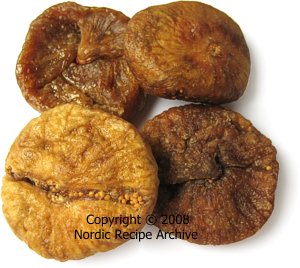
In Finland, dried figs are usually eaten out of hand. They are also added to cakes, cookies, fruit salads, puddings and ice creams, or cooked into jam or marmalade. Either dry or rehydrated, figs may be served to accompany many meat and game dishes, added to various stews or
served as a dessert with ice cream, whipped cream, etc.
Read about fresh figs here.
|
|
Prune
(Prunus domestica)

Prunes are dried red or purple plums of certain varieties. Some varieties of fresh plums that are especially suited to be dried are also called prunes.
Prunes are available either pitted or with stones.
In Finland, prunes are eaten as a snack or added to various sweet or savoury dishes, like cakes, pastries, stews, salads, etc. They are used to make compotes, fruit soups, purees and mousses.
For most dishes, prunes are rehydrated by soaking them in liquid.
Read about fresh plums here.
|
Dried apricot
(Prunus armeniaca)
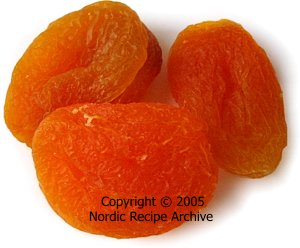
Dried apricots can be eaten as a snack or added to many sweet dishes, like fruit compotes and soups, cakes, pies, sweet or savoury salads, etc. They can also be served to accompany meat and game dishes.
Dried apricots may be rehydrated by soaking them in liquid.
In Finland, dried apricots are used much in the same way as dried prunes (see left).
Read about fresh apricots here.
|
|
Dried apple
(Malus × domestica)
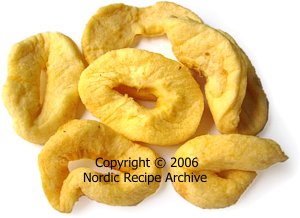
Apples are peeled, cored and cut into slices before drying into leathery rings. Dried apple may be eaten as a snack or added to many sweet or savoury dishes. Pieces of dried apple are added to fruit cakes, compotes, stuffings, muesli mixes, etc.
Besides eaten out of hand, in Finland dried apple mixed with prunes, raisins and other dried fruits is mostly used to make fruit compotes.
Read about fresh apples here.
|
Dried coconut
(Cocos nucifera)
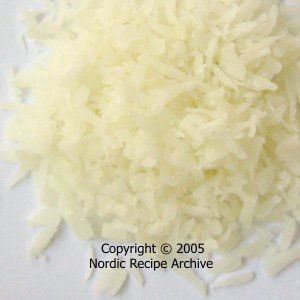
In Finland, dried unsweetened coconut is mostly available in desiccated (shredded) form. It is mainly used in baking and sweet desserts.
Enthusiasm for ethnic cooking has taught the Finns to use coconut also in savoury dishes.
Other forms of dried coconut (unsweetened, sweetened, toasted, etc) may be found sold in well-equipped Finnish grocery stores or various ethnic and specialty food stores.
In picture above: desiccated coconut.
In picture below: coconut flakes.

Desiccated or flaked coconut can be added to muesli, used as topping on cakes, muffins, etc, or mixed with water or milk to extract coconut milk.
Read more about coconut here.
|
|
|
Other dried fruits
 Besides the fruits listed above, other fruits frequently dried include pear, banana, pineapple, mango, papaya, peach, kiwi, melon, persimmon, cherry, carob, tomato and berries like cranberries, bilberries, lingonberries and strawberries, among others.
Besides the fruits listed above, other fruits frequently dried include pear, banana, pineapple, mango, papaya, peach, kiwi, melon, persimmon, cherry, carob, tomato and berries like cranberries, bilberries, lingonberries and strawberries, among others.
Most of these dried fruits are eaten as snacks or added to cake batters, puddings, compotes, ice creams, parfaits, sweetmeats and other desserts, various meat stews or stuffings, cereal and muesli mixes, etc.
|
|
|
CANDIED FRUITS
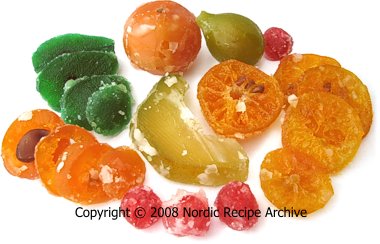 Also called crystallised fruits, candied fruits are made by preserving fresh fruits or their rinds in sugar. The fruits are repeatedly soaked in thick sugar syrups, until their moisture content is replaced with sugar. The fruits are drained and dried. They can be coated with a layer of
sugar to prevent sticking during storing.
Also called crystallised fruits, candied fruits are made by preserving fresh fruits or their rinds in sugar. The fruits are repeatedly soaked in thick sugar syrups, until their moisture content is replaced with sugar. The fruits are drained and dried. They can be coated with a layer of
sugar to prevent sticking during storing.
Fruits frequently candied include oranges, citrons, lemons and other citrus fruit and peel, cherries, plums, apricots, pears, strawberries, dates, figs, pineapples, melons and their rind.
Candied fruits may be eaten as candy, they are added to fruit cakes, puddings, ice creams, mincemeat mixes and other desserts, or used as decoration.
 Unlike in Central Europe, whole candied fruits are hard to find in Finnish stores, since they are nowadays hardly ever eaten here as snacks or candies.
At the delicatessen counter of their famous café in central Helsinki, the confectionery manufacturer Fazer used to sell candied citrus slices, which used to be a favourite treat in my family for decades, but unfortunately, they have no longer been available for years.
Unlike in Central Europe, whole candied fruits are hard to find in Finnish stores, since they are nowadays hardly ever eaten here as snacks or candies.
At the delicatessen counter of their famous café in central Helsinki, the confectionery manufacturer Fazer used to sell candied citrus slices, which used to be a favourite treat in my family for decades, but unfortunately, they have no longer been available for years.
In picture on right: crystallised violet petals.
Nowadays, only chopped candied orange peel, citron peel and whole or chopped candied cherries of mainly inferior quality in regards to taste can be found sold in Finnish grocery stores. They are mostly used in domestic baking and cooking.
 Candied items like ginger, angelica stems and violet or rose petals are less used in Finnish cooking.
Candied items like ginger, angelica stems and violet or rose petals are less used in Finnish cooking.
In picture on right: candied stems of angelica.
Good-quality candied fruits for eating out of hand may perhaps be found at some deli counters of gourmet stores and market halls in Finland.
|
|
|

